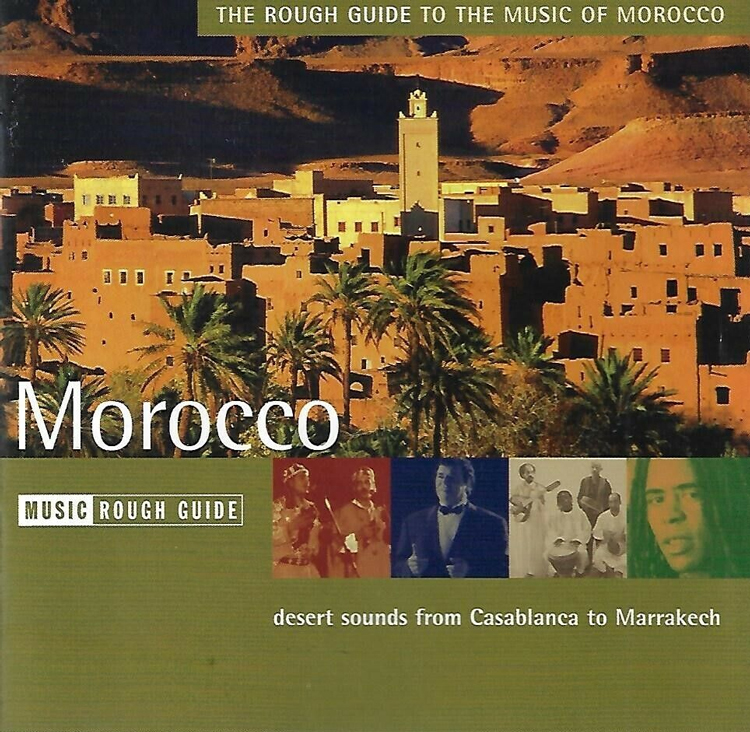San Francisco, USA – World Music Network, the label behind the Rough Guide series, releases today The Rough Guide to the Music of Morocco (RGNET1128CD). Morocco is a musical wonderland, stuffed with a bewildering surfeit of sounds; raw, sophisticated, ancient, modern, acoustic, electronic, mellow, fierce, deeply spiritual and extravagantly hedonistic.
Culturally fed by rivers flowing in from all directions, its musical gene pool is rich and diverse, although the unique legacy of Morocco’s own native Berber culture remains more rooted than any imported influences. This album features two of Morocco’s musical giants, Jil Jilala and Nass El Ghiwane, the best-loved Moroccan female group, Bnet Marrakech, and the greatest al aita star of modern times, Fatna Bent El Houcine.
Delving into some of Morocco’s musical traditions, such as melhoun and gnawa, The Rough Guide to the Music of Morocco also features some of the more contemporary and electronic sounds to have emerged out of this culturally rich country.
Over the past few decades, gnawa has become a worldwide musical force. Emerging out of a distinct Afro-Moroccan culture, it adheres to the Sufi tradition of Islam. Nass El Ghiwane did more than any other group to bring gnawa out of its ghetto and haul it into the limelight. This group from Casablanca is probably the most important, respected, adored and revered Moroccan combo of modern times. Once dubbed by Martin Scorsese as ‘The Rolling Stones of North Africa’ their songs combined the legacy of the ghiwane, who were traditional itinerant musician actors, and the booming trance of the gnawa and hamadja.
Although the group’s founder died in a car crash in 1974, the remaining foursome continued to dominate Moroccan and Maghrebi music for years to come. Parallel in outlook to Nass El Ghiwane and equally popular, was Jil Jilala, or ‘The Jilala Generation’. Also from Casablanca, they instilled a new pride in Morocco’s own musical traditions by delving into the sumptuous legacy of melhoun, gnawa, the music of the Jilali (a religious brotherhood) and rural Berber traditions in general, to come up with a new and utterly compelling sound. Delighting in using new and different musical elements, the group Nass Marrakech display another approach to gnawa. Having collaborated with a bewildering array of global musicians, they personify a promising new breed of Moroccan groups with an open, outward-looking attitude.
The unique legacy of Morocco’s own native Berber culture has played a huge role in the country’s music. Al aita (‘the cry’) was born on the coastal plains between Safi and Salé at the end of the nineteenth century, and earned its name from the scalping power of the voices (mainly female) that characterize the music. Fatna Bent El Houcine is the greatest al aita star of modern times and produces a wild intensity and driving rhythms. She travels with her group of female backing vocalists, or cheikhates, and an all-male backing band. Despite singing in Arabic, the roots of her musical style are Berber.
Bnet Marrakech are another overtly Berber group of cheikhates from Morocco’s deep south. After fifteen years together, ‘The Girls From Marrakech’ have emerged as one of the best-loved Moroccan female groups at home and abroad. Performing traditional Berber songs, they incorporate diverse influences of chaabi and gnawa music into their fundamentally Berber mix. Delivering songs with joyous defiance, ‘Leilaa Lill’ is a celebration of the night, and all its potential pleasures.
Newer chaabi or popular groups have a hard time shaking off the shadow of the musical giants Nass El Ghiwane and Jil Jilala. More recent chaabi tends to be lighter and more geared towards fun and partying. Najm El Farah Essafi and Mustapha Bourgogne are both examples of the funky angular soul of Moroccan pop, fusing modern keyboards, guitars, and drum machines with older instruments such as the darbuka, bendir and violin. In recent years a huge interest in rap has emerged and on ‘Hijra’, Dar Gnawa, two rappers from Casablanca, teamed up with the London-based, Morocco-born DJ and producer U-cef.
Mohamed Amenzou is one of the melhoun greats. Originally a popular form of oral poetry, the melhoun tradition is still very much alive in Morocco, and Amenzou delivers the gorgeous verses of the melhoun canon with deep emotion. Also featured on this album is, whose music is a powerful reminder of the lesser known Jewish history in Morocco.
Buy The Rough Guide to the Music of Morocco.


